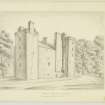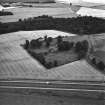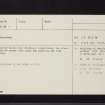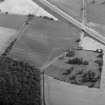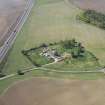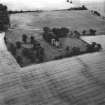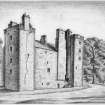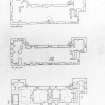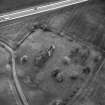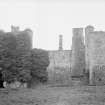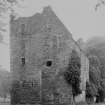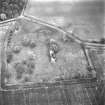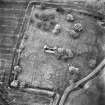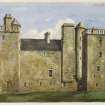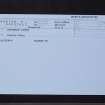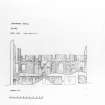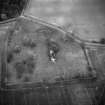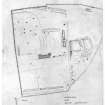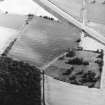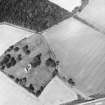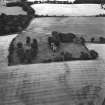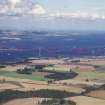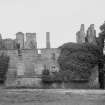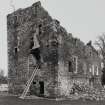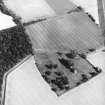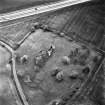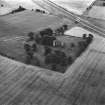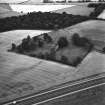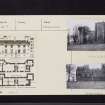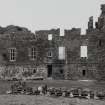Duntarvie Castle
Country House (16th Century), Garden (Period Unassigned)(Possible)
Site Name Duntarvie Castle
Classification Country House (16th Century), Garden (Period Unassigned)(Possible)
Canmore ID 49175
Site Number NT07NE 9
NGR NT 09050 76477
Datum OSGB36 - NGR
Permalink http://canmore.org.uk/site/49175
- Council West Lothian
- Parish Abercorn (West Lothian)
- Former Region Lothian
- Former District West Lothian
- Former County West Lothian
Duntarvie, early 17th century
Long Scots Renaissance villa (a rare straight stair leads from the front door to the principal floor) flanked by two wings symmetrically placed against the north façade, each with a balustraded flat top and turreted turnpike stair corbelled from the first floor. Undergoing snail's pace reoccupation. Unusually handsome farmhouse, c.1855, with crowstepped dormer windows and porch.
Taken from "West Lothian: An Illustrated Architectural Guide", by Stuart Eydmann, Richard Jaques and Charles McKean, 2008. Published by the Rutland Press http://www.rias.org.uk
NT07NE 9 0905 7647.
(NT 0905 7647) Duntarvie Castle (NR) (remains of)
OS 6" map (1967)
Now roofless and neglected, Duntarvie Castle is a fairly large late 16th century house, though its style would suggest a date of at least a century later. It consists of an oblong main block, four storeys high, with square towers of five storeys attached to its N angles. In the re-entrant angles thus formed, tall stair-turrets are corbelled out about first-floor level. These rise higher again then the tower roofs, to which they give access, and end in stone-roofed cap-houses.
It was probably built for James Durham who was granted the lands of Duntarvie in 1588; later acquired by the Hopes and added to Hopetoun Estate.
D MacGibbon and T Ross 1888; RCAHMS 1929, visited 1926; N Tranter 1962; SDD List 1964.
As described.
Visited by OS (JLD) 31 December 1952 and (JP) 25 March 1974
Duntarvie Castle was originally symmetrical; the piece at the SW corner (see plan) was added in the 17th century.
C McWilliam 1978
Photographed by the RCAHMS in 1980.
(Undated) information in NMRS.
Possible 17th century garden.
N Hynd 1984
NT 090 764. In the course of a programme of restoration works, AOC (Scotland) Ltd monitored the removal of modern rubble from within the W wing of the building (December 1994 to January 1995). All work was suspended in late January due to the unsafe condition of the building in high winds. Within a few days, part of the E tower collapsed and, at the time of writing, the programme of restoration works has not resumed on site.
Sponsor: Ed Kelly (architect), for Geoffrey Nicholsby (owner)
J O'Sullivan 1995
NT 090 764 In the course of a programme of restoration works at Duntarvie Castle (NMRS NT07NE 9), the excavation of foundation trenches around the ruinous E tower was monitored. These foundations form the first stage of the restoration of the tower after its partial collapse in 1995. The watching brief was the latest in a series of preparatory works associated with the renovation of the castle (O'Sullivan 1995). No significant archaeological sediments or artefacts were observed in the course of these works.
Sponsor: Ed Kelly (architect), for Geoffrey Nicholsby (owner).
R McCullagh 1999
NT 0905 7647 A watching brief was conducted to supervise the removal of vegetation and soil deposits that had amassed on the W tower of Duntarvie Castle. These works are part of a continuing programme of restoration work on the castle.
The watching brief revealed no evidence for the use of clay as a sealant in the construction of the roof. Very little of the original roof was in situ, with even the surviving drainage and gutter stones slipped or skewed.
Sponsor: Ed Kelly Architects.
L Dunbar and Murray Cook 2000
NT 0905 7647 An archaeological record was made in July 2001 of masonry at Duntarvie Castle (NMRS NT07NE 9), including part of the W gable wall, and several hundred architectural fragments located around the castle.
Sponsor: Ed Kelly (Architects) for Mr Nicholsby.
G Ewart, P Sharman and A Hollinrake 2001.
Standing Building Recording (July 2001)
NT 0905 7647 An archaeological record was made in July 2001 of masonry at Duntarvie Castle (NMRS NT07NE 9), including part of the W gable wall, and several hundred architectural fragments located around the castle.
Sponsor: Ed Kelly (Architects) for Mr Nicholsby.
G Ewart, P Sharman and A Hollinrake 2001.
Standing Building Recording (15 September 2009 - 5 December 2010)
A level 4 historic building survey was undertaken at Duntarvie Castle between 2009-2010. The work included laser scanning and comprehensive photographic survey. A reappraisal of the sites development has also been undertaken. The work was carried out according to the relative principles of a Cionservation Management Plan formulated for the building as part of Scheduled Monument Consent for a programme of refurbishment works.
Information from Oasis (cfaarcha1-92320) 17 February 2012
Watching Brief (May 2018)
NT 09048 76552 A watching brief was carried out, May
2018, during ground-breaking work to the immediate N and
E of Duntarvie Castle. The works were undertaken for a
marquee platform, an access road and service connections
to the marquee. No finds or features of archaeological
significance were identified.
Archive: NRHE (intended). Report: WoSAS
Funder: GTHC Pension Fund
Bruce Glendinning – CFA Archaeology Ltd
(Source: DES, Volume 19)
















































